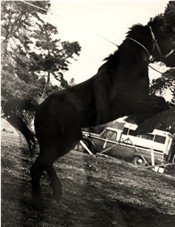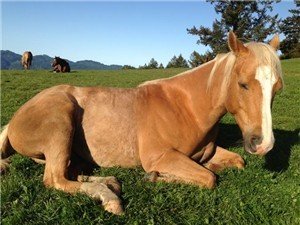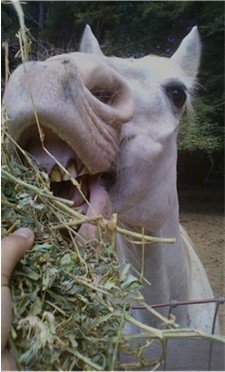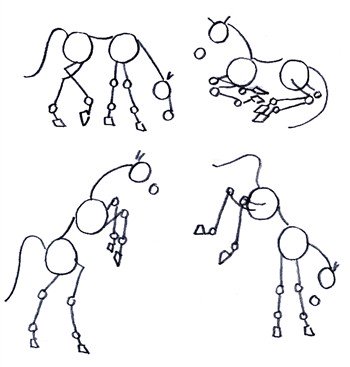Understand Horse Body Language and You’ll Unlock the Equine Communication Code
Your knowledge of horse body language is the key to working successfully with horses. Horses are constantly ‘talking’ to you and everyone around them, both people and other horses.
I don’t expect that horses will be learning to speak the English language anytime soon, so if we’re to have any meaningful communication with them at all, it is up to us to learn their language.
If you want understand what an equine is saying to you…you've got to learn to listen with your eyes. A horse’s body language is based on movement first and vocalizations second.
Horse body language that seems aggressive or dangerous (to people) is essential for horse-to-horse communication. The trick is in learning how to read horses and then placing yourself in a position of power, trust and respect.
A single body signal can have several different meanings. Because of this, you’ve got take into account the context in which it is used and what the rest of the body is saying to get the full meaning.

Horse Body Language – Ear Position Says so Much
Ears play a huge role in the body language of horses. Horses virtually can’t say anything without using their ears.
Windows to the Soul
They say, “Eyes are the window to the soul”. With horses it’s the ears that are the window to the soul!
Ears forward:
- I am looking ahead in my direction of travel
- I am focused on something out there, “What is that?”
- Hello and Salutations!
- I am interested
- I am curious
- Something has my attention
- I am on alert
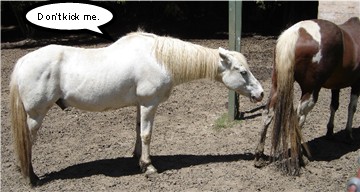 Ears back in a passive manner
Ears back in a passive mannerOne ear cocked back:
- I am paying attention to something behind me
- I am aware of something to the side of me
- I am paying attention to my rider
- I am aware of things in both directions
- I am thinking
Both ears cocked back:
- I am paying attention to something behind me
- I am listening to my rider
- A polite way of standing next to or behind other horses. ”I recognize your seniority, no need to kick me.” or “I’m boss over you, but you can relax, I’m not going to get you.”
- I am curious, but I’m not sure…maybe I’ll touch it with my nose while my ears watch my back!
Ears pinned back:
- Go away!
- I am angry
- I am scared and angry
- No!
- Don’t hurt me
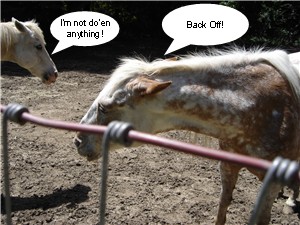 Ears back + head swing = non passive
Ears back + head swing = non passiveEars pinned flat to the skull:
- I am going to attack (usually accompanied by barred teeth and a snaky outstretched head and neck)
Ears relaxed to the side:
- I am relaxed
- I am contented or sleepy
- I am concentrating deeply
- I am listening for your next command
- When flopping while walking…I am thinking
Ears twitching quickly back and forth:
- I am nervous
- I am worried
- “How can I get away?”
- I am on the verge of panic

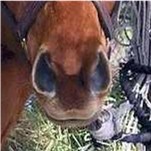 Something has my attention
Something has my attentionHorse Body Language – What the Nostrils Have to Say
Usually a horse will have their nostrils relaxed. They will flare their nostrils when they are hard at work and using a lot of oxygen, but when they flare their nostrils while at rest…it means something altogether different.
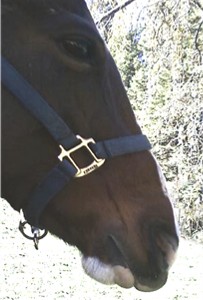 Pinched nose + angry eye = Warning!
Pinched nose + angry eye = Warning!Nostrils flared and wide open:
- I am on alert
- “What is that?”
- We meet for the first time
- What do you have?
- Curiosity
- Fear
- Worry
- Excitement
Nostrils pinched:
- I am angry
- I am irritated
- Watch out
- Don’t do it!
- Leave me alone

Horse Body Language – The Mouth Talks Too
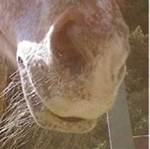 Relaxed muzzle = No worries
Relaxed muzzle = No worriesHorses are surprisingly expressive with their mouths. Not only do they use their sensitive muzzles to investigate things, they also do a lot of communicating with their mouths.
Muzzle relaxed or droopy:
- I am relaxed
- I am half asleep
- I am under the influence of a drug
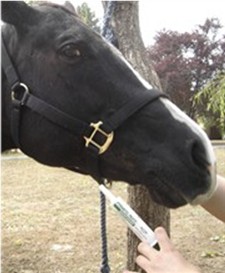 Tight muzzle + glaring eye = Tension
Tight muzzle + glaring eye = TensionMuzzle tight:
- I am irritated with you
- You’ve been warned
Licking Lips:
- I submit to you…you win
- Don’t hurt me
- I understand something
- I am letting go of tension
- I am starting to relax into the idea
- I am hungry...where's dinner?

Horse Body Language – Bites and Biting
Biting is an important form of communication for horses. Like all body signals, how and when it is used changes the meaning.
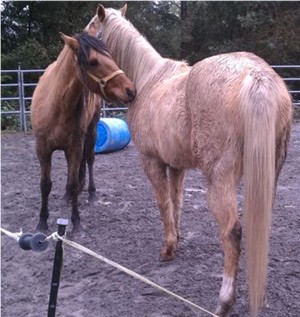 Horses bond with nuzzling and soft bites
Horses bond with nuzzling and soft bitesNuzzling:
- Affection
- Relaxation
- Bonding
A light nip:
- Tag…you’re it!
- Teasing…“You’re ugly and your Mama dresses you funny.”
- Not now…I’m busy
- Take off
- Love bites…Hey good lookin’!
- Don’t forget who’s boss
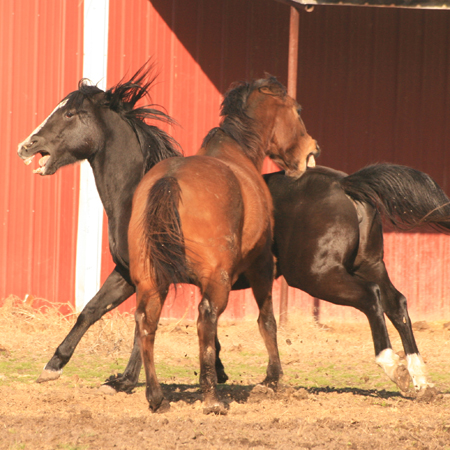 Biting establishes and maintains the pecking order
Biting establishes and maintains the pecking orderA Bite:
- Move it! I’m taking over
- I am the boss of you
- I have seniority over you
- Don’t touch me
- I am going to hurt you
- I am afraid
Biting in the air or at an object:
- Don’t hurt me
- I am worried
- I might bite you too
- Nervous energy

Horse Body Language – The Eyes Have It
|
The look in a horse’s eye is a very good indicator of his mood. It will also help you to interpret other body signals. Generally speaking a horse will have a bright open eye. Eye(s) half closed:
Showing the whites of the eyes:
Angry eye:
|
 Worried eye Worried eye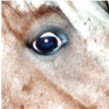 Frightened eye Frightened eye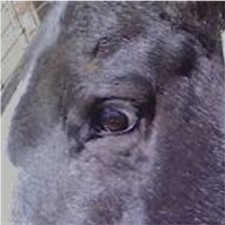 Angray eye Angray eye |

Horse Body Language – Kicks, Strikes and Pawing
Kicks are not just for protection. Just like biting, kicking is absolutely vital for communication between horses establishing and maintaining the pecking order.
|
Mock, fake and missed kicks (including no-contact cow kicks):
A light kick (by horse standards)
A Full on kick or strike:
Pawing the Ground:
|
 This horse kick says "back off!" This horse kick says "back off!" |

Horse Body Language – The Head and Tail as a Messenger
Horses use their heads and their tails to send signals to one another. These are two signals that can easily be seen from long distances.
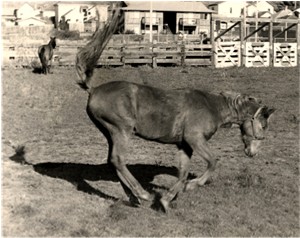 The higher the excitement, the higher the tail
The higher the excitement, the higher the tailTail raised:
- I am excited
- I am in Heat
- Hey everyone….Look at me!
- I love all the mares!
- Something has caught my attention
Tail swishing violently (not the shoo-fly tail)
- I am irritated
- I am frustrated
- I might kick next
- I am warning you
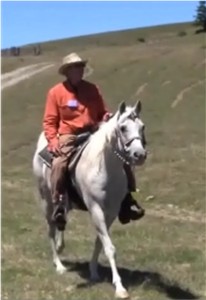 Head up, ears perkered, this horse is focused on something up ahead
Head up, ears perkered, this horse is focused on something up aheadA Lowered head:
- I am relaxed
- I am sleepy
- I am content
- I give in
- Very low to the ground…I am depressed
A raised head:
- I am alert
- Something has my attention
Head extended from an outstretched neck:
- I am going to bite you (with ears pinned flat)
- I want to touch it with out getting too close
Swinging the head with pinned ears or squeals:
- Back off
- Go away
- I’m warning you
- Teeth may follow

 These horses clearly do not want to engage
These horses clearly do not want to engageHorse Body Language – The Whole Body
As you can guess horses have a lot to say with the way they position their bodies as well.
Turning their back:
- Go way, not now
- I am submissive, you are the boss
- I don’t want to engage with you
- I am depressed, don’t talk to me
- While walking away…Follow me!
A Tense body:
- I am on alert
- I am frightened
- I am excited
- I am worried

Horse Body Language – Whinnies, Blows and Calls
Horses do have a fairly wide range of vocalizations as well. The sounds that horses make add emphasis to their body signals and act as long distance communications.
Soft nicker:
- Hello friend
- Greeting
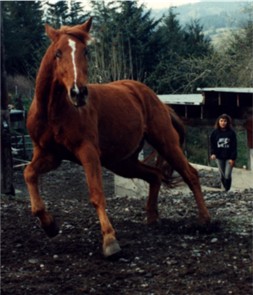 All wound up!
All wound up!A Whinnie:
- “Where are you?”
- “Anybody out there?”
- “Don’t leave me!”
- I am nervous
- I am excited
A Blow:
- VERY excited
- VERY nervous
- VERY alarmed
- Should I stand my ground or run?
- I am Energized!
Squeals and grunts:
- I am afraid
- I am going to yell at you while I get you!
- I am standing my ground (while stamping)
- Back off!
- While running - fear, anger or playful expression

 Can you tell which horse is dominant here?
Can you tell which horse is dominant here?Horses clearly have no problem understanding each other whatsoever. They usually sort out their differences in short order, albeit sometimes violently.
For us humans, being the small weaklings (by comparison) that we are, it is vital that we understand exactly what our horses are telling us, so we can take the appropriate measures.
Not only for our safety, but for every aspect of successful communication; training, riding and managing our horses.
|
The key is to watch all parts of the body. Note how they are used together and how they are used in context. Horses are honest. They do not lie. They may be smart and they may try to fool you, but they will always tell it like it is. Even sneaky old cantankerous broncs will inadvertently give themselves away with their body language…if you’re well versed enough to read it! So keep your eyes open and pay attention, especially to groups of horses out in the pasture. It's amazing how much you can learn simply by watching them interact with one another. And it’s fun too! P.S. The horse on the far left is the boss. The one in the middle is second in line and the one on the right is at the bottom. Notice the dominant horse has caused the other two to move and back off their positions. |
More Equine Topics You May Enjoy
Equine NutritionHave question about Equine Nutrition? How much to feed your horse? From salt blocks to grain choices it's all here. |
How to Draw a HorseSix easy step by step horse drawing lessons. Learn to draw horse heads and horse hooves too. |

